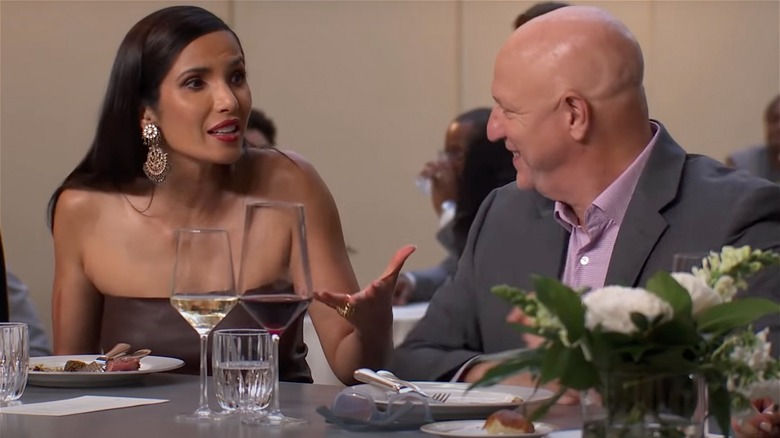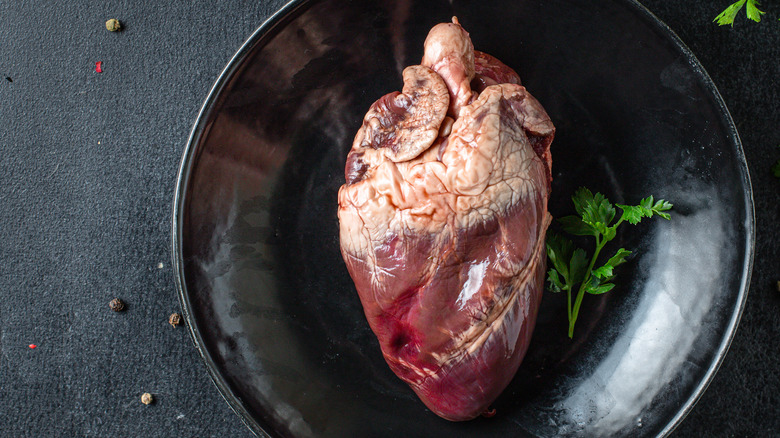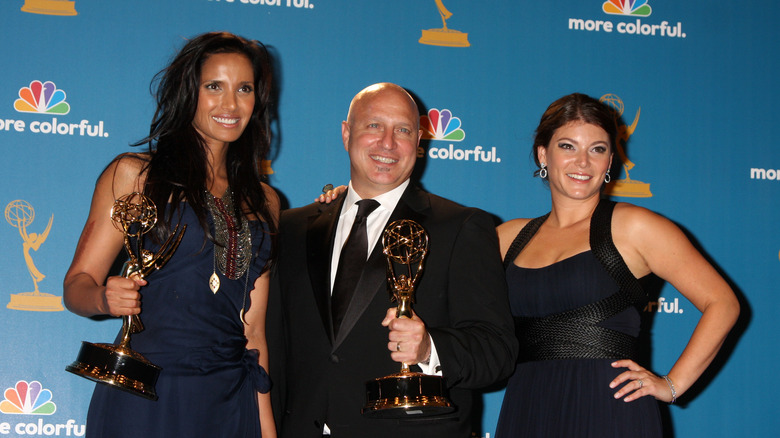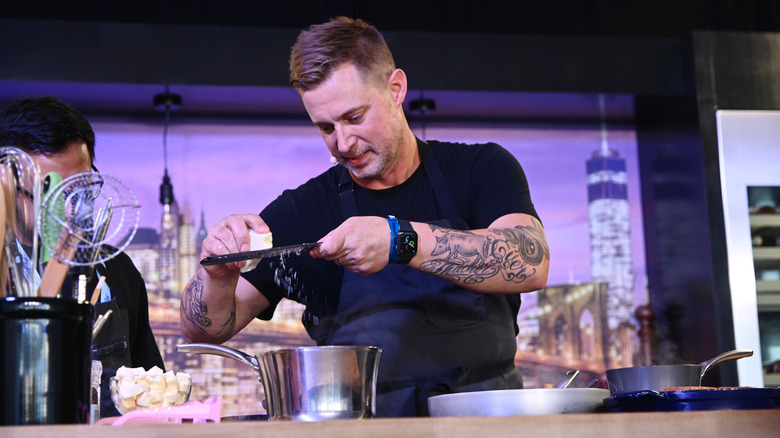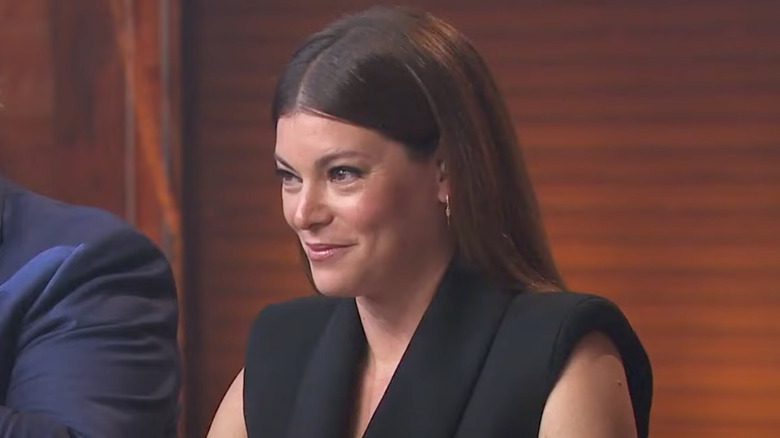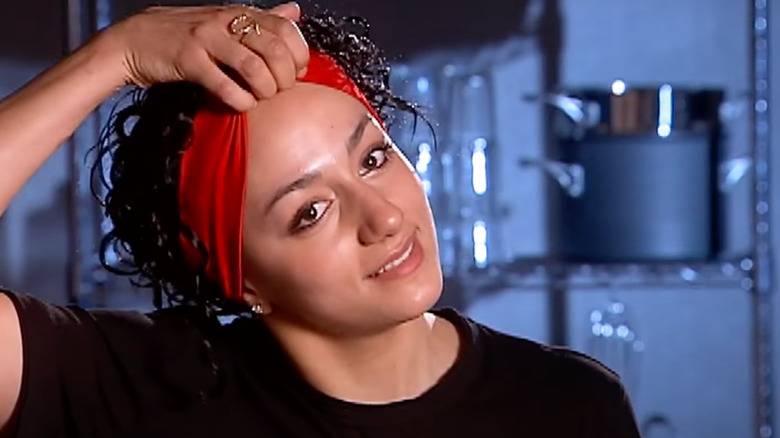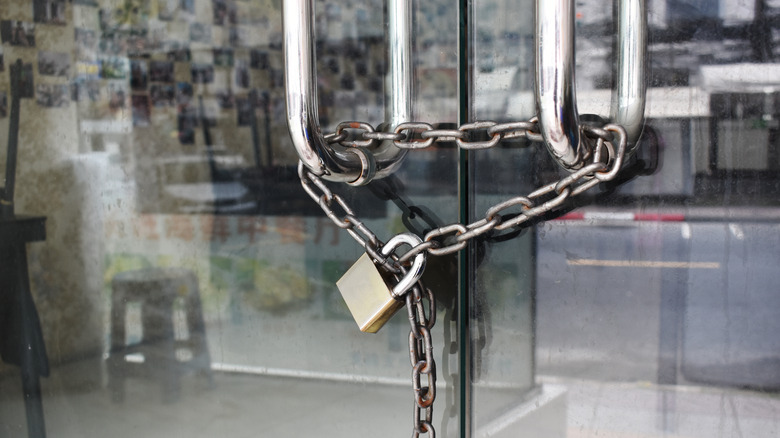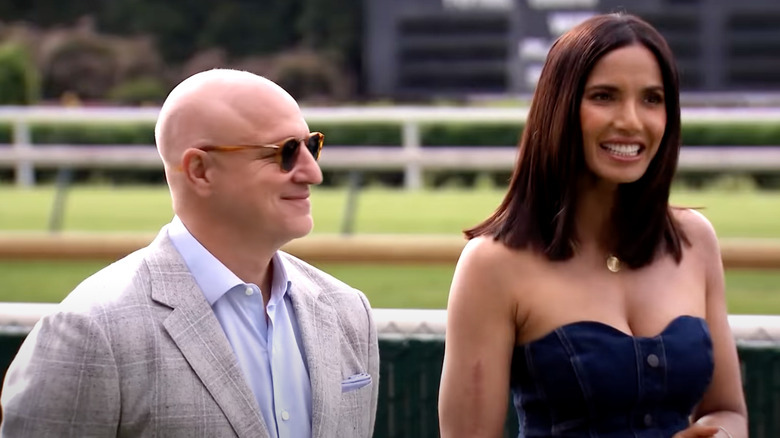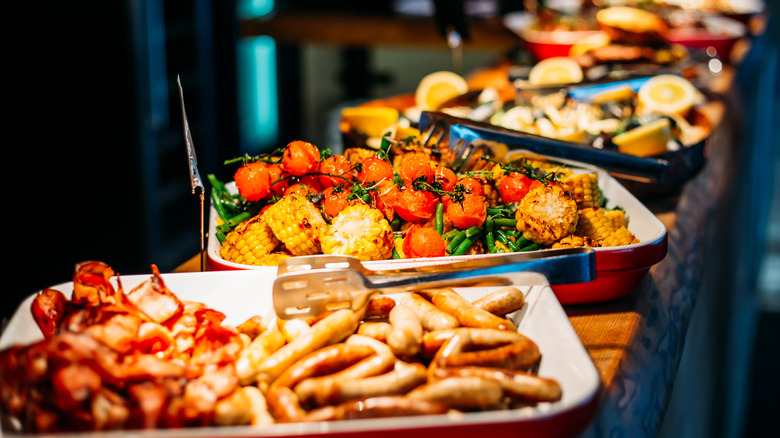What The Cameras Don't Show You On Top Chef
Since 2006, reality competition series "Top Chef" has graced televisions far and wide, and there is no doubt that some pretty interesting things have happened both on and off-screen over the years. Of course, we've seen some shocking eliminations, shocking wins, and shocking antics on the actual show. But did you know, for one thing, that contestants apparently are not allowed to have a basic household appliance in their rooms? Were you aware that there is someone who tries dishes but does not appear in front of the cameras, like some sort of phantom of the judges' table? And do you know what happens to all of the food that the cheftestants do not utilize during challenges?
Those questions only scratch the surface. If you're a "Top Chef" fan, or just someone who appreciates quality food related competition shows, keep on scrolling to learn what goes on behind the scenes of "Top Chef."
Padma Lakshmi consumes a lot of calories while filming
According to Medical News Today, in the United States, the average recommended caloric intake for female humans is 2,000 calories and 2,500 for male humans. (It's ultimately dependent on a whole host of variables besides gender, including but not limited to age, height, and lifestyle.) In a piece for The Hollywood Reporter written by the "Top Chef" host herself, Padma Lakshmi explained that during filming, she can end up consuming up to 8,000 calories a day and gain up to 17 pounds a season. As she shared with the outlet, she has to take at least two bites of each dish, and, as she put it, "It adds up."
Off-camera, Lakshmi told People, she tries to maintain a diet consisting of at least 50% fruits and vegetables. She does have a few foodie indulgences, though, because don't we all? Her favorite meat is a type of Indian street food called chaat, an umbrella term for the traditional savory dish. It usually consists of some type of fried dough with various salty, tangy, or spicy ingredients. Her favorite nighttime snack is a nice, healthy mug of raisin bran, per MyRecipes.com.
The judges really do have to try every dish
You might think that being a judge on "Top Chef" means you get to try all sorts of delicious sweet and savory dishes that no one else on earth (besides a select one or two) gets to try. And you're correct in that belief. But you can't have the simply decadent and tasty without also having absolutely horrific gastronomic catastrophes. As EW reported, Padma Lakshmi shared at a New York Times panel that it doesn't matter how horribly unappetizing a dish is — the judges still have to dig in.
But can these dishes really be that bad? Yes. Yes, they can. Take, for example, the culinary disaster from Season 2 that was chocolate ganache with a chicken liver stuck in the middle of it. This monstrosity was both conceived and concocted by Chef Ilan Hall, who actually went on to win the title of "Top Chef," and apparently, it was not exactly a culinary hit. "The worst thing I've ever eaten was the chocolate ganache with a morsel of liver in it," Padma Lakshmi said in the East Bay Times in 2008. Clearly, it stuck with her: Years later, she mentioned the dish again to Bravo's The Daily Dish, noting, "It was terrible!"
What are the judges' preferences?
Remember, the "Top Chef" judges are human, too. Take, for example, chef/judge Tom Colicchio. Over the course of the series, there have been a number of (sometimes incredibly heated) arguments that have broken out between competitors and Colicchio. You'd think that this kind of back talk would begin to wear on him. But apparently, he actually enjoys the pushback, stating in an interview with HuffPost in 2014, "I really don't care at all if they talk back. I mean, it's actually fun, and I'd rather they fight for themselves. I'd rather them say, 'you know what? You're wrong.'"
When it comes to food-related preferences, don't serve Gail Simmons black beans. In an interview with Lifestyle-NS, she explains that she has an aversion to this specific bean because in the past, she's gotten sick twice from eating them. (But she'll eat them in a professional setting if necessary.) And while she may not be totally averse to the dish, Padma Lakshmi told Us Weekly in 2019 that she was tired of the poke bowl craze.
A crew member acts as a tiebreaker
When the "Top Chef" judges are split 50/50, and it's 4 o'clock in the morning, and everyone is exhausted (and no one wants to even consider altering their opinion of the dish in question), it's time to call on the only other reputable source for unbiased food opinions. As executive producer Shauna Minoprio shared with the Daily News in 2007, they also run the dishes by a technical coordinator and set photographer who goes by T-Bone. "So he's sort of the inside mole, and if you want to get a sense of whose food tasted the best and who he thinks might do well at the judges' table, go ask T-Bone," Minoprio said.
So technically, you could say that "Top Chef" has three main judges, one or two guest judges, and an officially unofficial judge who gets to try the food without being required to share his takes on national TV.
Contestants are cut off from the outside world
While you may see chefs occasionally scrolling or talking on their phones in their downtime, it's a pretty common practice to keep competitors contact with the outside world to a minimum. It may seem pretty strict, especially when you think about being away from your friends and family for at least six weeks. What's more, contestants aren't supposed to tell people that they're participating on "Top Chef," as it would be a complete breach of contract, per Washington City Paper.
Season 6 alums Brian Voltaggio and Mike Isabella told the Washington City Paper that the setup can feel kind of like having your identity stolen. Season 4 competitor Spike Mendelsohn shared with the outlet that in order to make sure his family members didn't know he was on the show, he went as far as to create an elaborate coverup involving a bunch of prewritten emails.
What's more, Season 16 contestant David Viana told NorthJersey.com that they didn't have access to television or clocks while he was on the show. Marjorie Meek-Bradley of Season 13 also brought up the lack of clocks in their quarters, telling The Washington Post, "They say it's for congruity. I think they just want you to be crazy." While this may all sound like something from a social experiment, it's all ostensibly in an effort to prevent spoilers from leaking and to keep contestants focused on the competition.
The timeline for filming is pretty wonky
As previously mentioned, a good television show is just a series of camera shots that have been seamlessly edited together to create a storyline that engages viewers. That being said, it doesn't mean that each sequence was filmed in that exact order (or that one person's filmed reaction actually fits with what was said to them). That, friends, is the power of editing — and the power of suggestion, because editors can also use their revision prowess as a way to subliminally suggest to spectators that the "characters" they're watching aren't actually the way they are in real life.
In an interview with Parade, "Top Chef" judge Gail Simmons explains that everything you see at the judges' table is just a condensed (i.e., super edited) version of how the four judges came to their final decision. Editors have taken four hours (sometimes more) of footage and maxed it out at 12 minutes or less. Former producer Shannon Wilkinson told SeattleMet.com that filming can last anywhere from six to eight weeks, with a lag time of around two or so months between regular filming and filming the finale of the show. That's a lot of footage to condense into less than 60 minutes.
Show continuity is a big deal
If you're not really sure what the term "show continuity" means (or how it can make or break a TV show), then look no further. According to MasterClass, "Continuity is the principle of making sure that all details in a film or TV show are consistent from shot to shot and from scene to scene." Basically, it allows the show to seamlessly flow together and ultimately makes the story and plot line more believable. If you're looking for perhaps the most well-documented — and controversial — example of what a disturbance in show flow is, then take a look at one particularly infamous incident from Season 2 of "Top Chef." You know, the one where cheftestants Cliff Crooks, Sam Talbot, Ilan Hall, Elia Aboumrad, and Marcel Vigneron got into a hairy situation that involved booze, a video camera, and an electric razor.
Television show producers know that continuity is the through line. Without a through line, you have no story, and viewers lose interest in what they're watching, or even worse, they change the channel. Continuity is serious business: According to Insider, contestants for the "Great British Bake-Off" had to wear the same stanky clothes when they were being filmed for each particular episode, no matter how dirty they got.
Even if you're eliminated, you're not going home yet
"Pack your knives and go," is the phrase that you really just don't want to hear, and when you watch chefs get eliminated, most of them are, in fact, devastated. But just because they get the chop doesn't mean that they're allowed to go home. On the contrary. In an excerpt from the book "Notes from a Young Black Chef" (via RadarOnline), Season 13 cheftestant Kwame Onwuachi shares that the gap between the actual filming and the date the show is aired is so long that all the eliminated chefs are kept in a house until the season finale is filmed. In an interview with The Washington City Paper, "Top Chef" Season 6 contestant Mike Isabella noted that "rangers" kept tabs on the eliminated contestants while they're staying in said house. "If you go out, they go with you," he told the outlet.
A fairly common practice for reality TV competition programs, keeping all of the axed contestants cooped out throughout production is a way to try to thwart spoilers.
Competitors came to represent
As of this writing, "Top Chef" has filmed 19 seasons. According to the website TopChefStats.com, the grand total of cheftestants comes to a whopping 259. When it comes to gender, it's almost split 50/50, with 139 male participants and 120 female contestants. In March 2022, Out.com reported that 33 of the competitors identified as part of the LGBTQ community. Contestants have come from seven different countries (United States, Mexico, Canada, Puerto Rico, Italy, Vietnam and Malaysia) and represented 43 cities worldwide. Per, E! News, so far there have been three winners each from New York, Texas, and California.
While the show has gotten more diverse over the years, the judge/host of "Top Chef" has acknowledged in a number of interviews that there's still work to be done. Speaking with The Washington Post in 2020, Padma Lakshmi said, "[A]s an executive producer, I have been calling for more diversity among the cast and among our guest judges, specifically with more African American and Latinx voices, as well as women, for a long time. I bring it up at the start of every season, and I think while we have a long way to go, we are doing better."
Food does not go to waste, for the most part
According to SeattleMet.com, the culinary producers of "Top Chef" spend roughly $5,000 on food for the chefs to use during competition. This includes the quickfire rounds, which usually have an almost altar-esque table filled with artisanal cheeses, obscure meats, and brightly colored fruits and veggies as the competition's focal point. And if you've watched at least one episode of "Top Chef," you know that this elaborate culinary setup usually remains untouched by chefy hands.
So what happens to this table overflowing with that looks like a homage to the foodie gods? Shannon Wilkinson, the former culinary producer for "Top Chef," told SeattleMet.com, "Since these challenges were often weeks apart, we would take any leftover product that would have spoiled back to the hotel and have dinner parties." Even so, Wilkinson noted that there was always some food that did not get eaten before expiration date, and so, it went in the trash because, ya know, it's not exactly safe to consume spoiled food. "We always made sure the caviar was saved," he added.
Joining the show involves a lot of steps
Applying to compete on a "Top Chef" isn't for the faint of heart. To start, the website TopChefCasting.com shows that there are certain basic eligibility requirements that you need to meet before even considering applying (at least 21 years of age, legal citizen of the United States, and not a candidate for public office).
If you fit the basic eligibility criteria, you need to then preregister on their website, and if chosen, attend an open casting call at a specified location. If you can't make the casting call, you need to fill out an online application and also send in an audition video. (By the way, the online application is 18 pages long and very, very thorough.) If you make it to the final round, you can also expect to undergo rigorous psychological evaluations. Per The Hollywood Reporter, at a 2018 panel hosted by the Los Angeles Times, series alumni shared that the aforementioned eval included questions like, "Did you ever want to light a cat on fire?" Frankly, it's a good question to ask just about anyone.
The payout is big, but taxes are taken out
When it comes to the very end of the very last episode of each "Top Chef" season, there are two things that are very clear: Someone just got really rich really quick, and unfortunately, that same person isn't going to be keeping the entire amount of massive moolah. It's sad, but true, because whoever wins the massive payout will also have to pay out some massive cash to Big Brother — and no, we don't mean the reality show.
According to TopChefStats.com, over the course of 18 seasons, over $3.4 million has been awarded. In the first five seasons, the "Top Chef" champion won $100,000. However, this amount increased substantially over the next few seasons, and as of Season 18, the prize money had jumped to $250,000. However, as pointed out in Forbes, all game show winnings are taxed by the federal government as normal income (bummer), and that the IRS can tax up to 37%. It's amazing how that $250,000 score could shrink to $157,000 — and that's not even factoring in the amount owed to the state.
